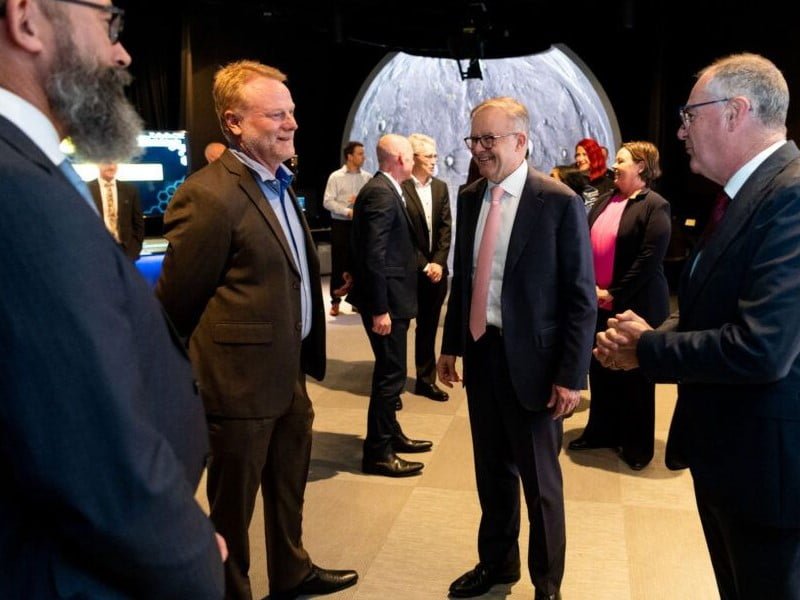The Curtin University-led Trailblazer hub is emerging from “startup” mode, with around 30 projects already being developed and a commercialisation accelerator set to be announced later this month.
Rohan McDougal, the Resources Technology and Critical Minerals Trailblazer hub’s director, spoke to InnovationAus.com about the work, which is backed by the equivalent of more than $200 million in government, industry, and university commitments.
The federal government’s $370.3 million University Trailblazer program funds six hubs focused in different technology priorities to pilot new partnership models supporting university-industry research and commercialisation projects.
University-industry partnerships at Curtin’s resources tech and critical minerals hub fall under three pillars of operation: improving technology readiness, commercialisation of technology, and a new accelerator program which will offer equity-free grants to startups.

Mr McDougall said the hub was emerging from “startup mode”, having spent most of 2023 recruiting people. Its work agenda includes several university-industry projects in addition to developing new incentives and rewards for research staff engaging in commercialisation activity or wanting to work in industry.
The Trailblazer Universities program was first announced by the former Coalition government in November 2021. Program grant agreements for $50 million over the four years to 2025-26 were signed in late 2022, according to a Department of Education spokesperson, with the funding to be matched in-kind and in-cash by the universities.
The Curtin-led Resources Technology and Critical Minerals Trailblazer, which includes the University of Queensland and James Cook University as founding partners, was the first to be announced.
Mr McDougall said there are also 33 corporate partners in the Trailblazer, including gas giant Woodside, Optus, and battery metals miner IGO, with the remaining partners mostly comprised of “mid-tier miners and smaller companies”. Rio Tinto is also involved but is considered a “peripheral partner”.
There are roughly $100 million worth of corporate partner commitments, half of which will be made through internal investments at the partner company.
“For example, if there’s a company, let’s say like Pilbara Minerals who are building a pilot plant for a new lithium process…and they want to collaborate with the university on having researchers come in and work on helping to write that process and analyse and optimise it, you can count the spend they have on the pilot plant as a contribution,” Mr McDougall said.
The other half of the commitments will come through research project funding, the provision of infrastructure, and reserving capital for equity investments in companies commercialising new technologies.
Most of the roughly 30 university-industry projects underway are with “middle tier” companies that are “operating well but probably don’t have capacity to have their own research teams”, Mr McDougall said.
Overall, there’s around 60 projects at “different stages of consideration”, including Digital Stack, a project that is supported by Optus and Cisco.
Its aim is to stimulate innovation by creating an open access mining software platform that can integrate the different digital systems used across the mining process.
“Big companies invest in their own systems, but a lot of the systems don’t talk together across the whole mining process from discovery and exploration through to…mine operations, and then the logistics of supply.
“Some of the big suppliers like Honeywell and others kind of lock down their own systems and it’s very difficult for new applications to come in.”
In the early stages of the Curtin-led Trailblazer the hub’s board, chaired by experienced mining executive Dr Vanessa Guthrie, was the sole approval mechanism for projects.
Sub-committees in line with each of the three pillars of operation, and led by the Trailblazer’s board directors, are now largely responsible for approving projects that are less than $750,000.
Beyond the delivery of more university-industry research and commercialisation projects, the Trailblazer hubs are expected to develop new incentives and rewards for research staff engaging with industry and commercialisation work.
Mr McDougall said Curtin University intends to develop performance metrics for researchers and research institutions beyond the focus on “peer reviewed journals and Citation Index”. This will build on a report on ‘Research Assessment in Australia: Evidence for Modernisation’ that was commissioned by the Office of the Chief Scientist last year.
He said conversations with the Department of Education have indicated universities could consider industry experience “a bonus to becoming a professor as opposed to” just a gap in publishing. Mr McDougall said this could be supported by measuring the “number of academic staff that have been promoted based on their industry experience versus traditional academic measurements”.
In collaboration with other trailblazer universities, a benchmark study will consider whether university-industry assessment metrics implemented at leading universities, such as the Massachusetts Institute of Technology, Waterloo University in Canada, and Delft University of Technology in the Netherlands, are applicable in the Australian context.
A national forum between the Trailblazer hubs has also been established to collaborate where possible and avoid duplication.
The federal government is also an active participant with the Department of Education continuing consultations with the hubs and earmarking $45 million – of the $370.3 million committed to the Trailblazer Universities Program – for partnerships between participating universities and the CSIRO.
Mr McDougall said that four years for the Trailblazer program is “not very long in terms of transformation of a culture and also impact in economic terms” but stakeholders “want to see this programme be successful”.







